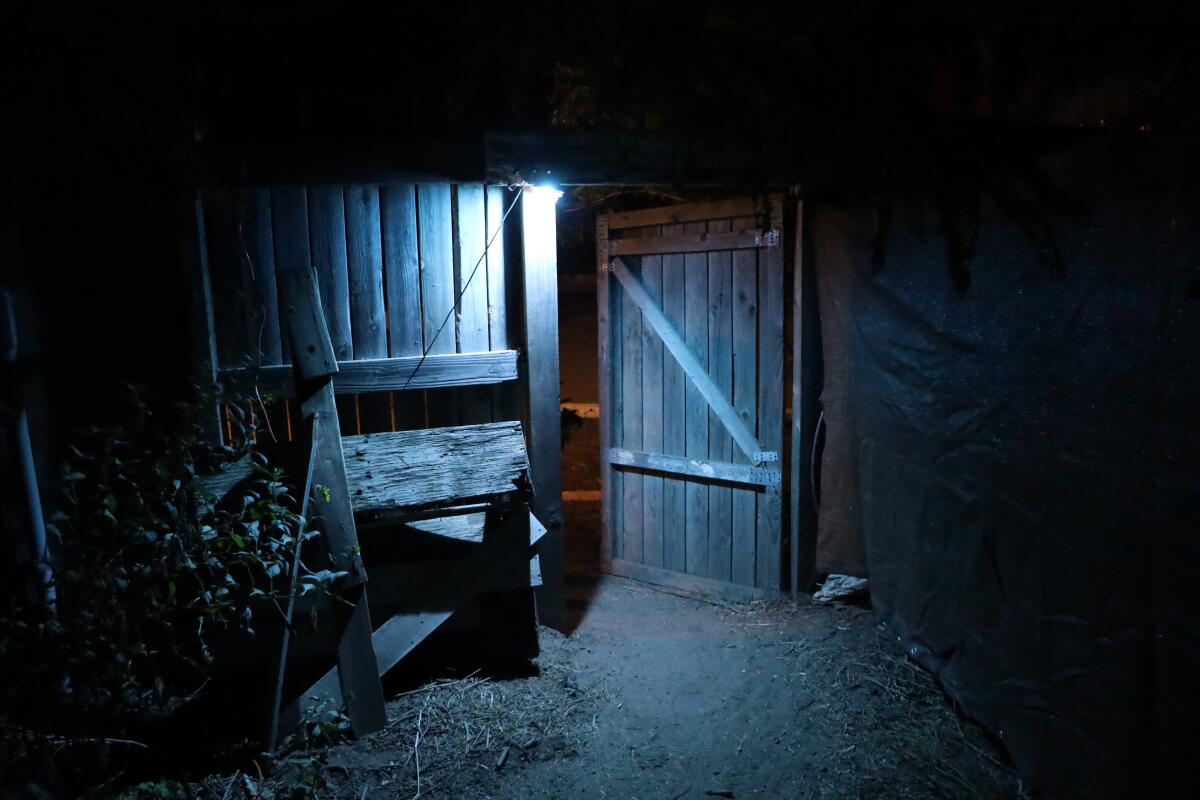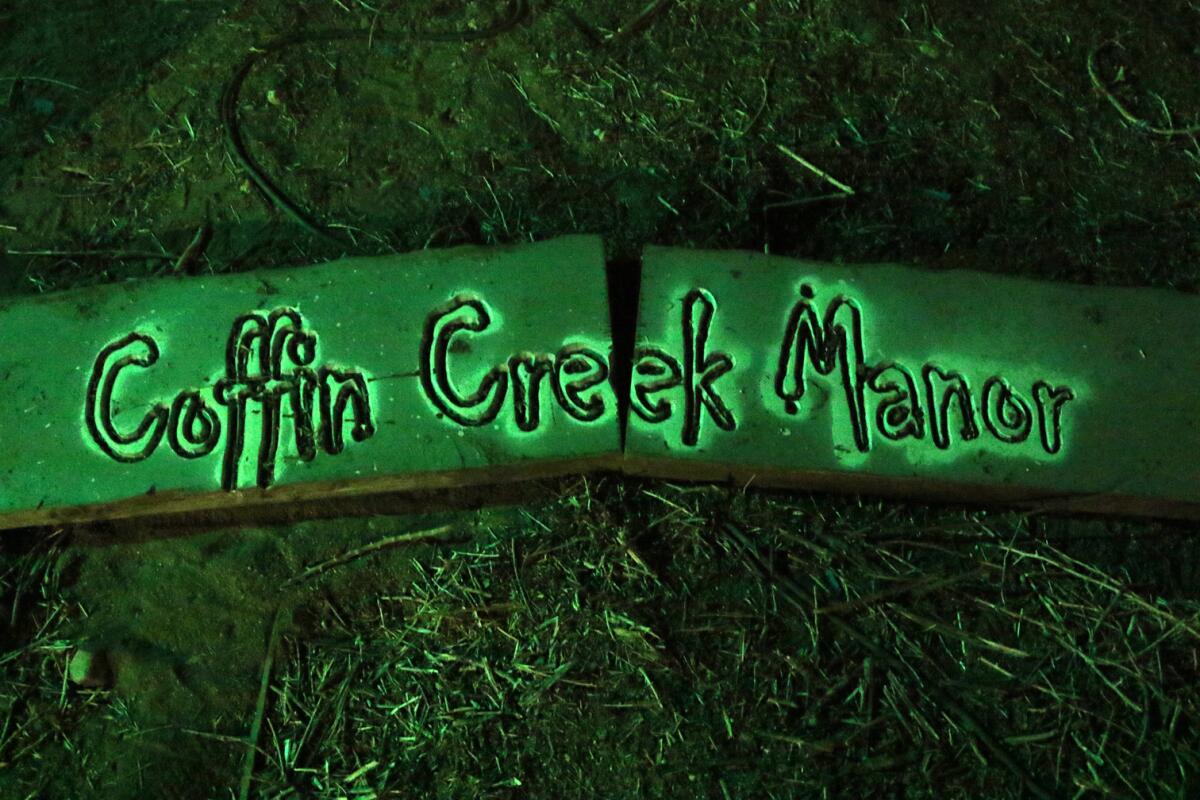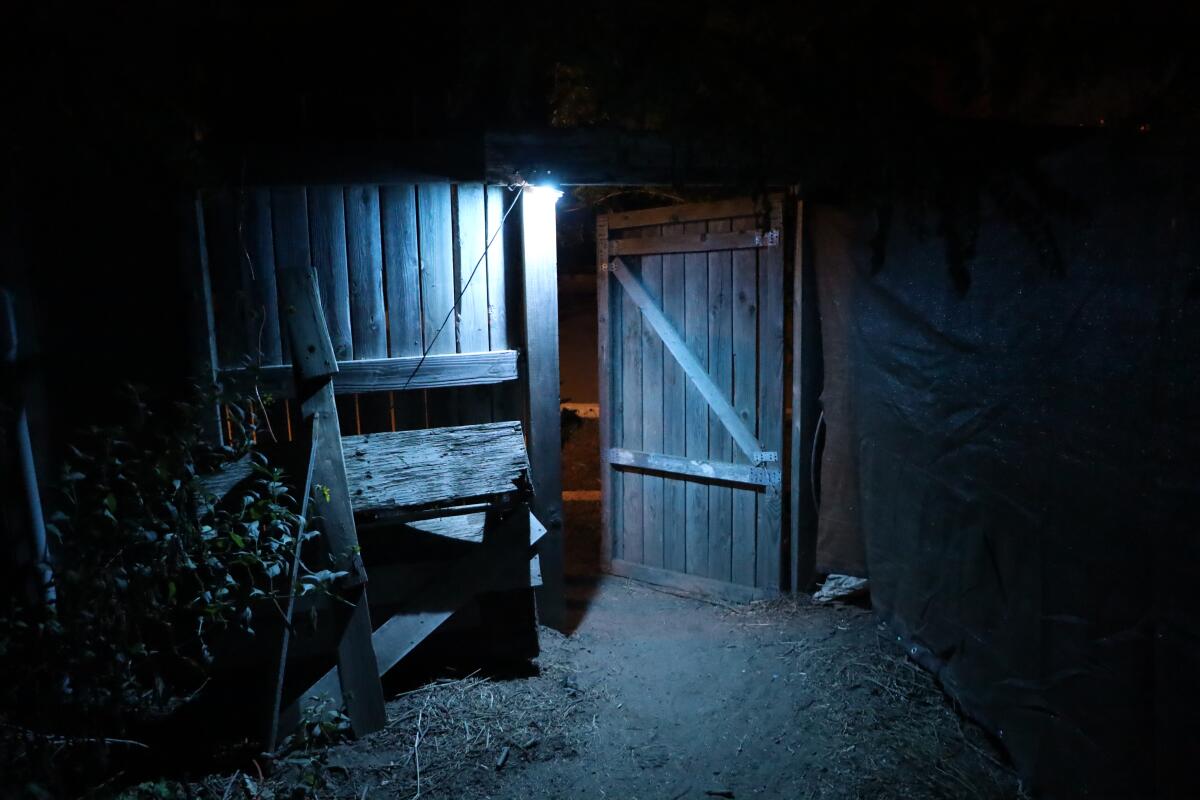Coffin Creek wasn’t SoCal’s flashiest haunted attraction. But it always got the scream
These days, a night at one of SoCal’s most popular haunted attractions usually begins with attendants scanning digital tickets at a clearly marked entrance.
At Coffin Creek, things were a little different.
Those who made the journey to Corona’s annual haunt entered an eerie scene the moment they veered off the 71 Freeway and down the desolate roads to Riverview Recreation Park, where Coffin Creek made its home. In the parking area, the dust kicked up by the vehicles created its own layer of fog, and sounds could be heard in the darkness — faint screams, the echo of chain saws and the nervous chatter of the hauntgoers. There was always a sense of mystery and excitement: With its independent, grassroots vibe, Coffin Creek — one of the longest-running Halloween attractions in Southern California — was the little haunt that could.
Coffin Creek has had its final run. Its founder and operator, Gary Shireman, passed away last month at the age of 74. But its legend lives on in the community of Halloween enthusiasts.

Coffin Creek, situated at Riverview Recreation Park, had a rustic feel, which added to the spookiness.
(Warren So)
While Coffin Creek, which at times went by the name Crossroads Haunted Village, was essentially a destination populated by several independently owned and operated haunted mazes, Shireman was the head of the operation. An electrician by trade and a longtime horror fan, Shireman launched the enterprise in 2007 after spending years searching for a location. He landed upon 180 acres of a park in Corona near the Santa Ana River. And as he soon discovered, it was already haunted, perhaps.
The backstory of the Coffin Creek locale — at least as it’s told through a newspaper story on the haunt’s website — is that in 1938, a massive flood hit Southern California, unearthing 13 coffins in Corona from an abandoned cemetery. Only some of the human remains from those coffins were recovered, and soon people in the area began seeing and hearing strange things at night.
Local artists and volunteers worked all year to open Coffin Creek, which was never a production as flashy or refined as Universal’s Halloween Horror Nights, Knott’s Scary Farm or any of SoCal’s well-established haunted maze destinations — but that was part of the allure. The darkness of the woods and muddy terrain was just as effective scenery as any of the bedsheet drapery or wooden flats that had been set up. While a discerning guest may have noticed that some of the haunted set pieces were missing a little paint or not lighted all that well, the cackling heard from the dark spaces in between reminded folks that it was all about the final thrill. One could never tell when a chain-saw-wielding madman was about to jump out from behind a wall.

The sign for the Coffin Creek Manor maze.
(Scott Feinblatt)
“Gary’s mazes were very old-school and very low-tech, and he was a big proponent of that,” said Warren So, a contributor for Hollywood Gothique, an online guide to all things horror in L.A. “He felt that all we need is a good old-school scare. As long as people scream, then it’s successful.”
In one 2011 interview, Shireman said he would work all year for that “first scream of the season.” Some attendees would take one step through the front door and come right back out.
The mazes at Coffin Creek had names like Chambers of the Mausoleum, Labyrinth of Lost Relics, Bog of the Abyss, the Dark Realm and Coffin Creek Manor, the legend’s namesake. One of the most endearing aspects of the destination was that several of the mazes took residence in the permanent structures that composed the medieval-inspired village of the Koroneburg Renaissance Festival on the park’s grounds.

A scare actor ready for his next victim.
(Scott Feinblatt)
Actors played all types of ghoulish creatures, including orcs and vampires. Uncle Zed’s Zombie Safari, which was one of several haunted hayride-style attractions that appeared over the years, even featured something of a community-sourced collection of monsters, all of which originated from independent contributions to the Secure, Contain, Protect (SCP) horror subgenre. Guests of this Coffin Creek attraction were carted along from one breached containment scenario to the next, with roving monsters periodically surprising them in the darkness between the scantily lighted vignettes.
Steve Biodrowski, the owner and operator of Hollywood Gothique, said Shireman worked tirelessly behind the scenes, dealing not only with the haunt’s creation but also with all the red tape that came with operating at the Corona park. Biodrowski recalled Shireman telling him about the complex nature of its ownership. “There were like four different owners,” Biodrowsky explained. “One was federal, and I believe it had something to do with the Army; then there were state and local departments involved. Getting everybody to sign on to a deal or agree to allow the haunted village to operate was just near impossible.”

Clowns haunted the premises — and visitors’ dreams.
(Scott Feinblatt)
Over the years of Coffin Creek’s various incarnations, a number of ancillary attractions complemented the mazes: a magic show, horror merchandise vendors and food stands. Some of the haunts included higher production value effects — Chambers of the Mausoleum, for instance, featured inventive animatronics from its principal operator, Figment Foundry. Even by the mid-2010s during a proliferation of local haunted attractions, the village downsized but the mazes never lost their charm. By continually utilizing veneers and components from past maze builds, the distinctive landscape and the talents of passionate, volunteers, Shireman continued to conjure an entertaining enterprise.
His passion for haunted attractions did not end at Coffin Creek. In 2022, Shireman partnered with haunt producer Jason Thompson to host the Haunt X convention at the Fairplex in Pomona. The event provided independent haunt owners and artisans an opportunity to network, learn trade techniques and showcase their enterprises and goods with one another and with their fans.
“He wasn’t just into haunted houses,” So said of Shireman. “He was always bouncing ideas about other Halloween stuff that was family-friendly — not scary — for the kids.” Additionally, So said that Shireman was generous with the community. “He loved talking to you about your haunt and his haunt and sharing ideas. I think everybody would agree that he was always willing to help. Another buddy of mine was building his haunted house, and even though it had nothing to do with Gary, he was down to help out and build out in the heat, in the desert. And Gary did not benefit one single cent. That’s just the guy he was — he doesn’t ask for anything and just wants to make a friend and help make a good haunt.”

The legend of the Coffin Creek location is that a flood hit Southern California, unearthing 13 coffins from an abandoned cemetery.
(Scott Feinblatt)
Shortly before his death, Shireman expressed enthusiasm about Coffin Creek’s future. He had announced that the haunt would be moving to a new Riverside location, the Lake Perris Fairgrounds, where it would operate in tandem with the Perris Pumpkin Patch. That couldn’t happen, but the Perris Pumpkin Patch has been operational this season and remains a family-friendly destination.
And while the haunt may have ended, like with any good maze, there may always be something more lurking ahead.











